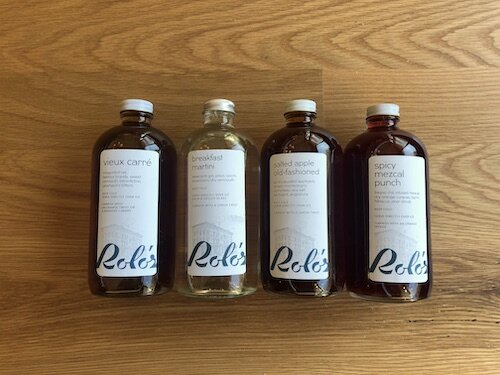6 Tips for Making Better Batched Cocktails To Go
Lost Lake This is the Way to Burn To Go Cocktail Photo Credit Shelby Allsion
Bartenders share their best advice for making batched cocktails that will be bottled and sold for takeout and delivery.
During the pandemic, many states started allowing restaurants and bars to package drinks to go, in an effort to limit congregating and indoor seating. States like New York, California, and Florida began allowing bottled alcoholic drinks to be sold last spring, and many businesses quickly jumped on board, making batched cocktails for the highest efficiency. While not new, batched cocktails have surged in popularity during the pandemic. But making a large batch of cocktails to be bottled and sold later is a different animal than crafting a singular cocktail that will be drunken immediately. If you’re still figuring out the magic of batched cocktails, we spoke to mixologists across the country to get their tips on making large-format cocktails so you can up your skills and make the best-bottled cocktail possible
Rolo's
1. Don’t Use Highly Perishable Ingredients
The number one tip we heard over and over was to be careful with using fresh ingredients. If you anticipate the batched drink sitting on a shelf for a while, be sure to avoid things like egg whites, dairy, bubbles, or more delicate or fresh syrups that have fresh fruit or vegetables in them, says Dan Dufek, the Beverage Director at New Land Enterprises, which runs Milwaukee’s food hall Crossroads Collective. Citrus is another tricky ingredient. Partner and beverage director Ben Howell of Rolo’s, a market and prepared food and drinks spot that opened in Brooklyn at the end of 2020, says, “As many bartenders know, citrus juice deteriorates quickly when added to cocktails, and is usually a component that is added at the last minute.” Since that’s not possible with batched cocktails, he suggests creating a cordial with citrus juice by cooking it down with sugar, adding vodka, and fortifying it with citric acid. A shrub is another way to incorporate fruit flavors, he adds. “A shrub is made through an ancient technique of macerating fruit with sugar and then combining that with vinegar,” says Howell. “Once the vinegar and fruit syrup rest for a week, you’ll have a tart, flavorful cocktail component that will last for weeks.” In general, cocktails that are more spirit-focused will last longer.
Concord Hill Smoke Break mise en place by Lily Brown MST Creative PR
2. Infuse Your Booze
“Batched cocktails are a fun way to use new infusions or ingredients,” says Alanna Hanson, co-founder of Hanson of Sonoma Distillery in Sonoma, California, which started selling premade batched cocktails for pickup and local delivery last spring. The distillery makes vodka infused with ingredients like hibiscus flowers, teas, mulling spices, and fruit. Hanson recommends experimenting with infusing herbs and teas in agave or other sweeteners as well to add even more flavor. Graham Courter, bar manager of Main Street Meets in Chattanooga, Tennessee, which has been making batched cocktails to serve on draft for years, agrees. “I do several batched cocktails using tea infusions. Tea infuses into liquor quickly and can add depth easily on a large scale.” Bar manager Victor Bautista of Concord Hill in Brooklyn adds that he likes to infuse his spirits with citrus peels, spices, or dried fruit. “To eliminate any separation within the cocktail, I prefer to use dried fruits in my infusions rather than fresh fruit or juices. I let an infusion sit overnight or at least for three to four hours, and then strain the spirit using a coffee filter.” Concord Hill started making bespoke batched and bottled cocktails for customers this winter.
3. Add the Alcohol Last
It’s always best to start with the mixers and add the alcohol at the very end when making large-format drinks. Why? Bar Manager Jose Medina Camacho of Automatic Seafood & Oysters shares, “In case you mess up, it’s not going to cost you your booze.”
4. Pre-Dilute Your Drinks and/or Include Instructions on How to Serve
When making pre-batched cocktails, you’ll have to decide whether or not to add water, and you should let the customer know if you did and whether they should serve over ice or not. “A general rule is to add about 30 percent dilution, but this can vary from drink to drink,” says Alicia Arredondo, bar manager of Chicago’s Lost Lake, a tropical-themed bar currently serving to-go cocktails. “Always test your recipe (with dilution) prior to batching.” Lost Lake recently started a cocktail club where members receive several batched cocktail bottles each month.
5. Use the Right Equipment
At Rolo’s, Howell shares that he has been using a sort of “beverage dispenser ‘suitcase’ that holds two-and-a-half gallons of liquid.” There’s a spout, handle, and a screw cap that makes filling and cleaning easy, plus allows for good airflow. Barrel storing is a good option for certain spirit-forward drinks, and it can add an even more complex flavor as time passes. “An Old Fashioned or Negroni can actually benefit from this pre-batch method when stored in aging barrels where the ingredients meld together and oxygenate for a smoother, more complex expression,” explains Director of Beverage Courtney Bunn who oversees cocktail programs at all F&B outlets at The Ritz-Carlton, Los Angeles, and the JW Marriott Los Angeles at L.A. Live. Currently, the JW Marriott Los Angeles’ Glance Lobby Bar is serving five classic batched cocktails in to-go bottles, including an Old Fashioned, Manhattan, and Negroni.
6. Taste as You Go
This may seem obvious but it’s a step often forgotten. When it comes to batching, ingredients tend to settle differently than in a single-serve cocktail, advises Howell of Rolo’s. “I would suggest a lot of sampling and adjusting. Drink a cocktail a few times after the batch has been sitting to ensure the best result.”




